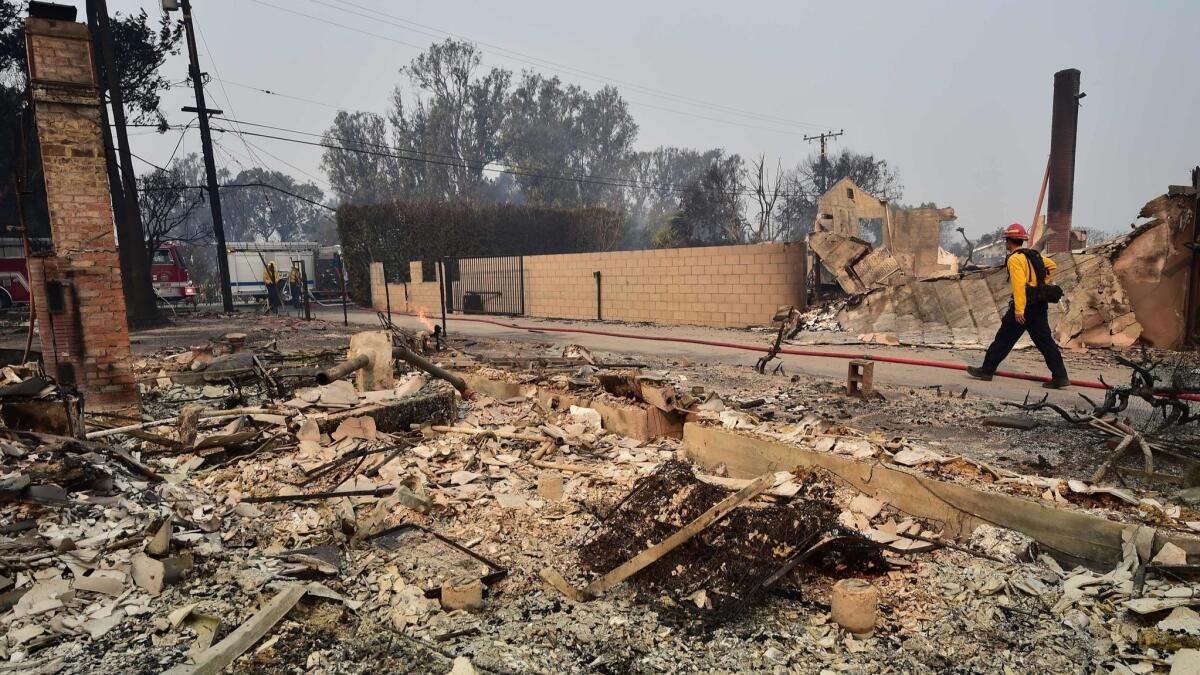Editorial: California is on fire. It won’t be the last time. Let’s get ready

From the north and from the south, California is on fire.
While communities in the Midwest woke up Saturday to snow on the ground, many Californians arose to a more threatening scene: their neighborhoods blanketed in a layer of ash, and the air thick with smoke.
Even from a distance, it’s hard to fathom the terror, the damage and the loss. Families scrambling to gather their precious belongings as the flames move closer. Displaced residents riveted to the TV, hoping for a glimpse of their neighborhood to see if their home survived. In a state accustomed to wildfire, this time Paradise literally burned to the ground, the quaint Sierra foothills town destroyed by a fast-moving fire that claimed at least nine lives and leveled some 6,700 buildings, from subdivisions to churches to fast-food restaurants — hallmarks of suburban living that once seemed insulated from the reach of wildfire.
In Los Angeles, two fires tore through the coastal hillsides, burning mansions and mobile homes and forcing 200,000 people to flee. Two people died. The entire city of Malibu was evacuated as the Woolsey fire burned toward the ocean. Zuma Beach — one of the most popular and picturesque stretches of Southern California’s coastline — became an apocalyptic scene as evacuees rushed to the water with their horses, dogs and llamas.
No one can ignore the fact there is something more complex to the devastation we’re seeing. Every year seems to bring bigger, more calamitous fires.
The television coverage has focused on scenes of stately homes in ashes, which are dramatic. But the fire losses are more devastating to the poor than the wealthy, because the wealthy have the means to recover.
In Thousand Oaks, still grieving from the horrific mass shooting at the Borderline Bar & Grill on Wednesday night, residents fled their homes to escape the fire. What had been a reunification center set up after the shooting was quickly turned into an evacuation center. It’s almost too much to bear as one community is forced to confront two disasters.
The scope of human suffering is beyond ready comprehension.
The threat remained high Saturday, as the fires continued to burn faster than they could be contained. Fire agencies were spread thin by the demand, and after years of drought, the conditions were especially dangerous.
“Our firefighters have been facing some extreme, tough fire conditions that they said that they’ve never seen in their lives,” L.A. County Fire Chief Daryl Osby said Saturday.
Much of California’s landscape is prone to burning, an ecological reality that doesn’t make the flames rolling through beloved communities any easier to accept. Yet no one can ignore the fact there is something more complex to the devastation we’re seeing. Every year seems to bring bigger, more calamitous fires.
Contrary to President Trump’s remarkably callous tweets, “gross mismanagement” of the state’s forests is not the cause. There are no forests in Malibu. Some of the most damaging fires in recent years have swept through grasslands and brush. The reasons for California’s growing wildfire threat are complex and the state needs a thoughtful, committed federal partner.
Climate change is amplifying natural variations in the weather. California has gone several seasons of drought. Coupled with warmer temperatures, the paucity of rainfall has dried out vegetation, creating more fuel for fire. As the continued burning of fossil fuels adds heat-trapping gases to the atmosphere and exacerbates the effects of climate change, the state is going to see more frequent, more destructive wildfires.
California has to retrofit itself to make communities more resistant to wildfires. Lawmakers made some progress on that front this year, dedicating $1 billion over five years to the expensive work of thinning the forests, cutting brush and setting controlled burns.
Enter the Fray: First takes on the news of the minute from L.A. Times Opinion »
But there’s still an urgent need to make existing communities more fire safe. That means more stringent building codes to require fire-resistant materials, such as tile roofs, on homes in communities at risk of fire. It means developing robust alert systems and having clearly defined evacuation plans.
Plus, the state needs to expand the areas designated high-risk fire zones to include suburban communities and cities that are vulnerable to these larger conflagrations. And perhaps most important, Californians have to rethink where we build. Continued sprawl into previously undeveloped areas puts life and property at risk.
For now, California is left to mourn the loss of life and the damage to property. When the last embers are out, California, again, must lead in the worldwide effort to cut greenhouse gases to slow climate change. At the same time, we have to adapt to the reality we’re already seeing and make the state more resilient for the wildfires coming next.
Follow the Opinion section on Twitter @latimesopinion and Facebook
UPDATES:
3:48 p.m.: This editorial was updated with additional editing for clarity.
More to Read
A cure for the common opinion
Get thought-provoking perspectives with our weekly newsletter.
You may occasionally receive promotional content from the Los Angeles Times.










